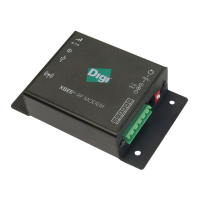Analog and digital I/O lines RSSI PWM
XBee/XBee-PRO® S2C ZigBee® RF Module
148
Example Sample AT Response
0x01 [1 sample set]
0x0C0C [Digital Inputs: DIO 2, 3, 10, 11 enabled]
0x03 [Analog Inputs: A/D 0, 1 enabled]
0x0408 [Digital input states: DIO 3, 10 high, DIO 2, 11 low]
0x03D0 [Analog input ADIO 0= 0x3D0]
0x0124 [Analog input ADIO 1=0x120]
Periodic I/O sampling
Periodic sampling allows a device to take an I/O sample and transmit it to a remote device at a
periodic rate. Use the IR command to set the periodic sample rate.
n To disable periodic sampling, set IR to 0.
n For all other IR values, the firmware samples data when IR milliseconds elapse and the sample
data transmits to a remote device.
The DH and DL commands determine the destination address of the I/O samples.
You can set DH and DL to 0 to transmit to the coordinator, or to the 64-bit address of the remote
device (SH and SL).
Only devices with API operating mode enabled send I/O data samples out their serial interface.
Devices that are in Transparent mode (AP = 0) discard the I/O data samples they receive. You must
configure at least one pin as a digital or ADC input to generate sample data.
A device with sleep enabled transmits periodic I/O samples at the IR rate until the ST time expires and
the device can resume sleeping.
Change detection sampling
You can configure devices to transmit a data sample immediately whenever a monitored digital I/O
pin changes state. The IC command is a bitmask used to set which digital I/O lines to monitor for a
state change. If one or more bits in IC is set, the device transmits an I/O sample as soon as it observes
a state change in one of the monitored digital I/O lines. Use DH and DL to specify the 64-bit address to
transmit change detection samples.
RSSI PWM
The XBee module features an RSSI/PWM pin (pin 7/SMT, pin 6/TH) that, if enabled, adjusts the PWM
output to indicate the signal strength of the last received packet. Use the P0 (P-zero) command to
enable the RSSI pulse width modulation (PWM) output on the pin. If P0 is set to 1 (and P1 is not set to
1), the RSSI/PWM pin outputs a pulse width modulated signal where the frequency adjusts based on
the received signal strength of the last packet. Otherwise, for all other P0 settings, use the pin for
general purpose IO.
When a data packet is received, if you set P0 to enable the RSSI/PWM feature, the RSSI PWM output
adjusts based on the RSSI of the last packet. The RSSI/PWM output is enabled for a time based on the
RP command. Each time the device receives an RF packet, the RSSI/PWM output adjusts based on the
RSSI of the new packet, and resets the RSSI timer. If the RSSI timer expires, the RSSI/PWM pin drives
low. RP is measured in 100ms units and defaults to a value of 40 (4 seconds).

